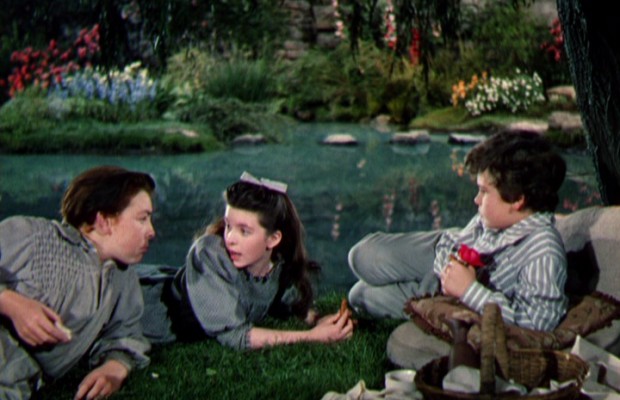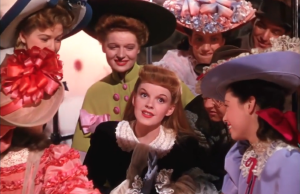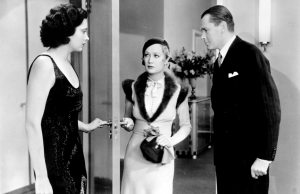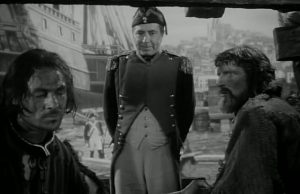The Secret Garden (1949)

Toronto Film Society presented The Secret Garden (1949) on Monday, September 15, 1980 in a double bill with Kiss Me Kate as part of the Season 33 Monday Evening Film Buff Series, Programme 1.
The author of the novel “The Secret Garden” made several contributions to the screen. Frances Hodgson Burnett (1849-1924) secured her fame with “Little Lord Fauntleroy” (1886), which was the basis of two films: in one (1921), Mary Pickford memorably played both little Cedric and his mother, and in the other (1936) Freddie Bartholomew furthered the career of playing endearing children which he had begun with David Copperfield. Mrs. Burnett’s novel “Sara Crewe” was also the basis of two films, entitled A/The Little Princess, the first with Pickford in 1917, and the second with Shirley Temple in 1939–escapist films in doom-laden years. “The Secret Garden” is a less well-known novel, but more durable and subtle than either “Little Lord Fauntleroy” or “Sara Crewe”. It was adapted to film in 1949 for another enormously popular child-actress, by then declining from her first great popularity towards adolescence. Margaret O’Brien was now twelve, some years past the charming tot of Journey for Margaret (1942), The Canterville Ghost and Meet Me in St. Louis (both 1944), and Our Vines Have Tender Grapes (1945). In this same year of 1949 she played the fated Beth in the remake of Little Women, and in the ’50s her career was over.
This story of the little orphaned girl who enters the lives of a invalid boy her won age, and his brooding, embittered father, and regenerates them both, is ideally suited to O’Brien, and also has able support from a distinguished cast; for once Herbert Marshall’s war wound enhances the role he plays. The most interesting technical effect, which derives directly from The Wizard of Oz (and perhaps ultimately from the Julian-Chaney version of The Phantom of the Opera!), is the colour sequence in the secret garden itself, a magical place away from the everyday black and white of reality. The film is predominantly sentimental, however, and lacks the psychological subtlety of a superb television version of the novel made and shown in the past couple of years.
One can perceive behind the film the hand of Clarence Brown, who had had a long career with MGM as Garbo’s preferred director and as the director of “serious”, middlebrow films (Emma–no relation to Jane Austen–and The Rains Came). Brown, who is the producer of The Secret Garden, became a much more sentimental director in the 1940s (The Human Comedy, National Velvet, The Yearling), and this film tends to underline that development. The actual director of the film was Fred M. Wilcox (1905-64), who made only eleven films, but who is most often credited with discovering not only Elizabeth Taylor, whom he directed in his first feature, Lassie Come Home (1943), but also the other, only less famous, star of that film; with her (Lassie, not Liz), he made two more films. Besides The Secret Garden, two of Wilcox’s other films are worthy of note: Shadow in the Sky (1951), a film dealing with the adjustment of a shell-shocked veteran to civilian life, and Forbidden Planet (1956), his best film, a science-fiction version of “The Tempest”, and a cultist work of recent years.
The movement from sentimental to “serious” in Wilcox’s career represents a more general movement. The Secret Garden was made at a time when the public was turning away from sentimental presentments of childhood; it was not even reviewed in the New York Times. Though Little Women did rank thirteenth at the box office in 1948-49, the list was led that year and the next by such films as Johnny Belinda and The Snake Pit; and event he comedies were dark or sophisticated: Apartment for Peggy, Adam’s Rib, and Cheaper by the Dozen (which owes its popularity less to a ssentimental view of large families than to Clifton Webb’s astringent wit, capitalizing on Sitting Pretty). The Secret Garden marks the end of the era of the sentimental child-star: after 1950 there would be no more child-stars of more than one or two films. The most memorable performances by children would be infilms far different: Patty McCormack in The Bad Seed in the ’50s, Sue Lyon in Lolita in the ’60s, and then on to Tatum O’Neal, Linda Blair, and Jodie Foster in the ’70s.
Notes by Barrie Hayne














Leave a Reply